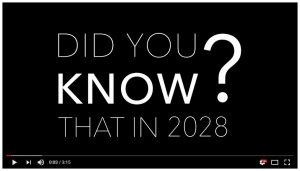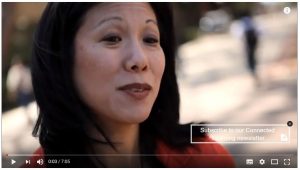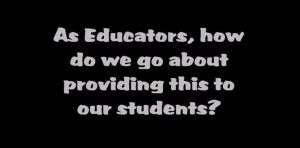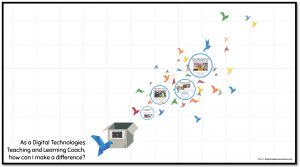The introduction of the internet cannot be accredited to any one person, rather a collection of thoughts and ideas that grew and developed over time. In as far back as the early 1900s, Nikola Tesla toyed with the idea of a “world wireless system”. The ‘world wide web’ as we know it, then took on a more recognisable form in 1990, when computer scientist Tim Berners-Lee invented the World Wide Web. (Andrews 2013)
Being ‘connected’ online, changed the world as we knew it, and in turn revolutionised almost everything about the way we live. With the introduction of modern technologies, smart phones and the internet, meant that tasks that once took days, weeks or months can now happen instantly at the press of a button or the swipe of a screen.
Educators are in a position where one must look at their professional pedagogy and personal practice, revisit what has always been done and determine what needs to be changed. As stated in the journal article; Teaching in the Connected Learning Classroom, ‘Classrooms of today look remarkably like classrooms and schools of the past….with desks and bells… and in nearly all respects, the classrooms and how they function today look strikingly the same as they have for decades. This stagnancy would not be much of a problem if the rest of society also remained in stasis. However, that’s simply not the case.’ Kids today are learning, engaging, and producing in richly productive and collaborative ways. Media products can now function as building blocks for unique and personalised productions. These new forms of engagement that we see shaping how youth learn and connect comprise what a research team spearheaded by Mimi Ito call “connected learning.” (Garcia 2014)
Contents
- 0.1 The issue at hand what do educators think?
- 0.2 So what is a Connected Digital Learner?
- 0.3
- 0.4 Connected Learners fostering Creative Cultures
- 0.5 Global Digital Citizens and the Globalisation of Learning
- 0.6 Engaged Digital Citizens in the information Environment
- 0.7
- 0.8 How does this impact students?
- 0.9 Re-imagining Education in the Digital Age and the Impact on Educators
- 0.10 Personal Reflection – How can I contribute as an Educator?
- 1 References –
The issue at hand what do educators think?
In order to determine how schools can best move forward in a world where ‘traditional’ educators are teaching digital native students, it is important to ask educators for their feedback and thoughts. An interview was conducted at Mernda Primary School in Victoria to discover more about the thoughts of highly accomplished teachers and how they felt about the impact that digital learning would have on education in the future.
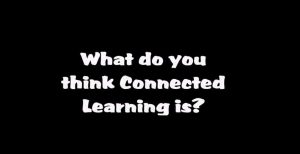
Through seeking the feedback and thoughts of current day, practicing teachers, it was evident that educators find it difficult to conceptualise just what they are preparing their students for and what skills are required to get there for both the teacher and student. Cox (2018) states that ‘Being a teacher in the digital world can be quite overwhelming. There are so many new innovative tools that many teachers feel they can’t keep up with them. Or they feel they are not given the support on how to effectively integrate them into their classrooms. One thing that everyone can agree upon is that a teacher’s role is changing, and technology in the classroom is here to stay.’ (para 4)
So what is a Connected Digital Learner?
In 2013 a research team, led by Mimi Ito, produced a report ‘Connected Learning: An Agenda for Research and Design’, they wrote that ‘Connected Learning is socially embedded, interest-driven, and oriented toward educational, economic, or political opportunity. Connected learning is realised when a young person pursues a personal interest or passion with the support of friends and caring adults, and is in turn able to link this learning and interest to academic achievement, career possibilities, or civic engagement.’ (Ito et al 2013)
The Connected Learning Alliance developed a framework to define the learning and design principles that make up Connected Learning. These principles include; production centred, peer supported, a shared purpose, academically orientated, openly networked and interest powered principles. All of these underpin their beliefs that digital connectivity can close the gap between wealthy and underprivileged people and therefore foster and enhance potential capabilities of all people. The Connected Learning Alliance argues that connected learning provides opportunities for collaborative online engagement where creativity and problem solving can be fostered and developed by like minded people. Irrespective of background, race or gender. ‘Connected learning isn’t a burden that one organization shoulders on its own, and is about building connections across different sites of learning.’(Connected Learning Alliance 2018)
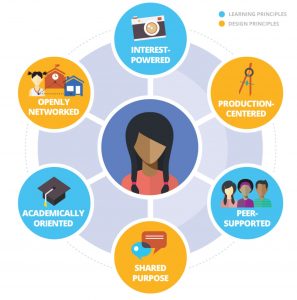 Principles of Connected Learning – Connected Learning Alliance
Principles of Connected Learning – Connected Learning Alliance
As described by Cooper et.al (2013) ‘Access to technology and teacher technology expertise both continue to play a major role in the nature of student learning experiences.’ These learning experiences and encouragement by teachers are fundamental for developing multi digital literacies and creativity. The shift from the teacher being the vessel of information, to the teacher assisting individuals to facilitate their learning is one that feels both daunting and new to the world of education. For educators, the following three concepts provide a starting point, to direct critical thinking towards adapting and changing the ways in which one teachers in a digitally connected world. These concepts raise thoughts and discussion points for evaluating the teacher’s role in preparing future ready multiliterate citizens.
Connected Learners fostering Creative Cultures
Being connected to one’s topic of research, with like-minded people, resources or even through a personal emotional connection, allows for a passionate and creative outlook on the task, this in turn fosters the potential for innovation and creativity. As discussed by Faultley & Savage (2010, p.6) the definition of creativity; involves mental processes, can involve action, is within a domain, is purposeful and is novel (to the individual – ‘everyday’ creativity). To teach creatively, an educator needs to release control to their students, take risks, encourage thought and provide students with the skills and tools for inquiring, problem solving and creating. To learn creatively, a student must have the skills to research, be confident in their own investigative skills and take risks outside of what they have always known.
Studies prove that game based digital learning assists to foster the creative processes and innovative thinking, despite ongoing arguments that online games are detrimental to young people, Routeledge (2009) explains that ‘Part of creating effective teaching tools involves understanding what works and doesn’t work for the learner. We have seen that learners and their preferences have changed, and some of the psychological reasons Games-Based Learning works and appeals to young people’. Whilst acknowledging that times have changed, the challenge here for educators, is to make this style of learning possible in school the environment, as we know them today.
Imagine if educators fostered a child’s creativeness….the possibilities are endless
Global Digital Citizens and the Globalisation of Learning
Always being able to learn everywhere and at any time of the day comes with many pros and cons. With the advent of social media, learning occurs anytime, anywhere, and students regularly pursue knowledge in networked and collaborative ways – with or without us. Emerging web technologies connect young people in ways never before possible. (Nussbaum-Beach 2012), this provides both opportunity and concerns for educators, as it is not only the potential for learning that one must consider, but also ensuring that today’s youth are protected and taught to stay safe when working online. Teaching in a globally connected world also results in the added responsibility of ensuring student privacy and online safety. Because of this, education departments all over the world are now revising privacy laws to incorporate globalised digital learning with the view of developing ethical citizens who display best practice while moving around an online space.
Despite the fact that the rapid pace of change can be somewhat daunting for educators, the potential to spread our wings in education is necessary and exciting. As Davies et. Al (2011) discusses that in the ‘6 Drivers of Change’, having ‘a globally connected world results in increased global interconnectivity putting diversity and adaptability at the centre of organisational operations.’ thus meaning that collectively, workplaces become efficient, adaptable, global and change ready. Schools embracing the globalisation of learning will effectively prepare their students for future employment and workplace readiness.
Engaged Digital Citizens in the information Environment
Some studies discuss that young people learn best when they are actively engaged, creating, solving problems that they care about and supported by peers who appreciate and recognize their accomplishments. With the birth of the information environment, people can now select any topic of interest and immerse themselves within the information environment. They can transform information such as music, videos and text, modify and communicate in an immeasurable variety of ways. Learning in such an environment opens up possibilities and caters for individuals in a depth that has never been possible before.
As described by the Revised Bloom’s Taxonomy Model, the Cognitive Processes Dimension categorises the cognitive process from low order thinking skills (Remembering and Understanding) through to higher order thinking such as Evaluating and Creating. Through using 1:1 personal devices to learn, research, create and collaborate with, learners of all ages can be catered for at all times, irrespective of where they are in the cognitive process.
How does this impact students?
Modern day educators are faced with the reality that many jobs will become obsolete in the near future, and that they are preparing students for careers that are not yet invented. A report drawn by The Committee for Economic Development of Australia (CEDA), found that ‘almost five million jobs face a high probability of being replaced in the next two decades, while a further 18.4 per cent of the workforce had a “medium probability” of their jobs being eliminated.’ (Florence and Partland 2015).
It is therefore imperative that teachers in today’s world; plan, expose and prepare their students for future readiness and functionality in the workplace, irrespective of conflicting viewpoints. As the generation gap is more prominent now that in the past, due to the rapid change of technology, experienced educators wrestle with personal pedagogy and beliefs around how much digital exposure a young learner should have. Selwyn (2012) however, points out that the ‘knowledge economy’ has an increasing impact on the future of production and manipulation of information and knowledge. This in turn has a major impact on the production of physical goods and services.
It was also argued by Chakravartty and Sarikakis (2006, p.22) that ’The ‘knowledge economy’ also symbolises the transition from manual/machine assisted production line of material things to an abstract, placeless interaction between human and electronic brains for the production of services’. Therefore, today’s students need to be prepared for a future in a rapidly changing workplace. Schooling should look to provide them with future ready skills.
Re-imagining Education in the Digital Age and the Impact on Educators
Although often criticised and argued by some as an unwanted development in education and detrimental to the core of teaching and learning, digital technology has arrived and is here to stay. There is now a need for educators to remain up to date and consistently challenge personal pedagogy and practice to review what effective and relevant education looks like in the 21st century.
The question raised is, ‘how do educators remain up to date in order to ensure that they are providing young learners with the skills they require?’ Education practitioners need to respond to changing and developing technology with an open mind and allow their practice to be flexible, innovative and creative. Educators need to see themselves first as lifelong learners and as teachers second. The starting point of ‘connectivism’ is the individual. Personal knowledge is comprised of a network, which feeds into organizations and institutions, which in turn feeds back into the network, and then continues to provide learning to individual. This cycle of knowledge development … allows learners to remain current in their field through the connections they have formed. (Siemens 2013)
Thoughts and reflections from Monique Iluk and Michelle Pangemanan (Teacher Educators)
Interestingly, Nussaum-Beach (2012) expresses that ‘although the technological revolution has permeated every other area of the society, education – often viewed as a reflection of culture and values – has been left largely untouched. This notion raises many questions as the education environment works to ‘catch up’ with the rapidly changing digital world.
Personal Reflection – How can I contribute as an Educator?
Word Count – 1974
References –
A model of learning objectives–based on a taxonomy for learning, teaching, and assessing: A revision of Bloom’s Taxonomy of Educational Objectives by Rex Heer, Center for Excellence in Learning and Teaching, Iowa State University. Retrieved from http://www.celt.iastate.edu/teaching/effective-teaching-practices/revised-blooms-taxonomy
Thomas, D & Seely Brown, J. (2011) A New Culture of Learning: Cultivating the Imagination for a World of Constant Change Retrieved from http://www.newcultureoflearning.com/
Andrews (2013) Who Invented the Internet. Retrieved from https://www.history.com/news/who-invented-the-internet
Australian Government – Office of the Australian Information Commissioner (2018) Retrieved from https://www.oaic.gov.au/media-and-speeches/news/
Britland, Matt – The Guardian (2013) What is the future of technology in education? Retrieved from https://www.theguardian.com/teacher-network/teacher-blog/2013/jun/19/technology-future-education-cloud-social-learning
Chakravartty, P. and Sarikakis, K. (2006). Media Policy Globalisation. Edinburgh, Edinburgh University Press.
Connected Learning Alliance – What is Connected Learning? Supported by the MacArthur Foundation. Retrieved from https://clalliance.org/why-connected-learning/
Cooper et al. (2013) Developing multiliteracies in a technology-mediated environment page 105 – Vol. 50, No.2, 93-107. Educational Media International, Routeledge Taylor & Francis Group
Cox, Janelle – Teach Hub.com (2018) Technology in the Classroom: Being a Teacher in the Digital Era. Retrieved from http://www.teachhub.com/technology-classroom-being-teacher-digital-era
Davies, A., Fidler, D., & Gorbis, M. (2011). Future work skills 2020. Page 5. Retrieved from http://www.iftf.org/uploads/media/SR-1382A_UPRI_future_work_skills_sm.pdf
Faulty, Martin and Savage, Jonathon (2010) Secondary Education Reflective Reader published by Learning Matters
Florance. L and Partland. L (June 2015) ABC News – Almost 40 per cent of Australian jobs could be replaced by technology by 2025 Retrieved from http://www.abc.net.au/news/2015-06-16/technology-could-make-almost-40pc-of-jobs-redundant-report/6548560
Garcia, Antero, ed., 2014. Teaching in the Connected Learning Classroom. Irvine, CA: Digital Media and Learning Research Hub. http://kpeppler.com/Docs/2014_Peppler_Teaching-in-the-CL-classroom.pdf
Goldstein, J. (2014). Get off my cloud: when privacy laws meet cloud computing. The Conversation. Retrieved from http://theconversation.com/get-off-my-cloud-when-privacy-laws-meet-cloud-computing-21001
Herald Sun Kid News – http://www.heraldsun.com.au/kids-news/lightbright/mobile-phones-digital-cameras-the-internet-and-planes-have-changed-how-we-live/news-story/c5aec6a426a25de07e26b6274b4778a1
Ito et al. (2013) Connected Learning: An Agenda for Research and Design, Education in the Creative Economy. New York NY: Peter Lang Publishing.
Ito Mimi, DML Research Hub (4 August 2011) Cultural Anthropologist Mimi Ito on Connecting Learning, Children, and Digital Media. Retrieved from https://www.youtube.com/watch?v=xuV7zcXigAI
Leonhard Gerd, TFA Studios (11 May 2016) Technology future Digital transformation: are you ready for exponential change? Retrieved from https://www.youtube.com/watch?v=ystdF6jN7hc&t=5s
Nussaum-Beach, (2012) The Connected Educator: Learning and Leading in a Digital Age Published by Solution Tree Press.
Routledge, H. (2009). Games-based learning in the classroom and how it can work!. In T. Connolly, M. Stansfield, & L. Boyle (Eds.) Games-Based learning advancements for multi-sensory human computer interfaces: Techniques and effective practices (pp. 274-286). Hershey, PA: . doi:10.4018/978-1-60566-360-9.ch016.
SAMR – Design Learning for Engagement (2014) Retrieved from http://tamritz.org/samr-design-learning-for-engagement-pt1/
Selwyn, Neil (2012). Education and technology: Developing a global perspective. Chapter 1. In Education in a Digital World : Global Perspectives on Technology and Education. Retrieved from http://www.csuau.eblib.com.ezproxy.csu.edu.au/patron/Read.aspx?p=1016089&pg=14
Siemens, George. Connectivism: A Learning Theory for the Digital Age p 5-7. Retrieved from http://er.dut.ac.za/bitstream/handle/123456789/69/Siemens_2005_Connectivism_A_learning_theory_for_the_digital_age.pdf?sequence=1&isAllowed=y
The Centre Online (29 December 2014) Did You Know? Retrieved from https://www.youtube.com/watch?v=QpEFjWbXog0

